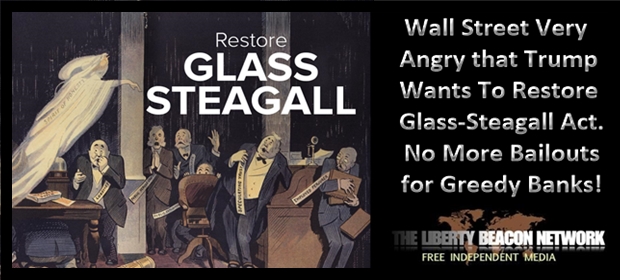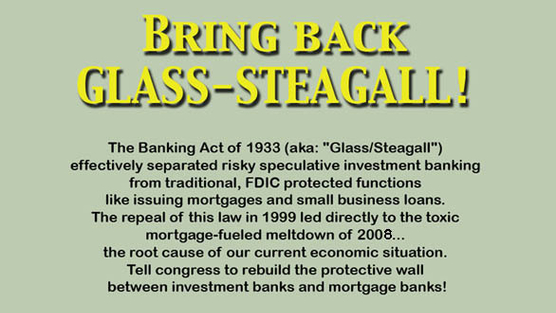 The central struggle since the inception of the Republic has been about the control of money. Since the U.S. Constitution clearly defines coinage, the objective of the mercantile elite was to circumvent the law and establish a National Bank. Woe to any defender of President Andrew Jackson for abolishing the Second Bank of the United States and rendering the Bankster Nicholas Biddle to his ignominious place in hell. This victory for the common man was ultimately betrayed when the Federal Reserve Central Bank was instituted with all the ills of fractional reserve banking.
The central struggle since the inception of the Republic has been about the control of money. Since the U.S. Constitution clearly defines coinage, the objective of the mercantile elite was to circumvent the law and establish a National Bank. Woe to any defender of President Andrew Jackson for abolishing the Second Bank of the United States and rendering the Bankster Nicholas Biddle to his ignominious place in hell. This victory for the common man was ultimately betrayed when the Federal Reserve Central Bank was instituted with all the ills of fractional reserve banking.
Since this treachery, the country was placed completely under the bondage yoke of debt created money. In the age of J.P. Morgan, the Jackals of Jekyll Island were able to implement the Rothschild scheme of the issuance of money by a private bank with the passage of the 1913 Federal Reserve Act. The inevitable reduction in purchasing value of Federal Reserve Notes and increase in the national debt provided the backdrop to the conditions that resulted in Black Tuesday October 29, 1929.
The need to establish governmental regulations to restore public confidence was obvious. Given that closing down the Fed, the crown jewel of the money changers was not politically possible, the Glass-Steagall Act was enacted.
“An act the U.S. Congress passed in 1933 as the Banking Act, which prohibited commercial banks from participating in the investment banking business.
The Glass-Steagall Act also created the Federal Deposit Insurance Corporation, which guaranteed bank deposits up to a specified limit. The Act also created the Federal Open Market Committee and introduced Regulation Q, which prohibited banks from paying interest on demand deposits and capped interest rates on other deposit products (it was repealed in July 2011).
The Glass-Steagall Act’s primary objectives were twofold – to stop the unprecedented run on banks and restore public confidence in the U.S. banking system; and to sever the linkages between commercial and investment banking that were believed to have been responsible for the 1929 market crash. The rationale for seeking the separation was the conflict of interest that arose when banks were engaged in both commercial and investment banking, and the tendency of such banks to engage in excessively speculative activity.”
The pattern of contrived financial panics was a main argument to create a central bank. However, the practice of lending requires an understanding of the Fractional Reserve Banking System. Loans made to fund commercial financing seems to be the obvious purpose of a bank. Yet before Glass-Steagall, the attraction to use the assets of a bank’s financial statement to gamble on controlling business ventures, fundamentally departed from loaning money to qualified borrowers. In the world of speculation banking, there is no such assurance of a safe investment.
With the passage of time and the greater consolidation of the Wall Street Plutocracy, the limitation on their ability to formulate new profit centers and financial instruments, targeted revoking Glass-Steagall. So when Bill Clinton defends repeal of Glass-Steagall, you get a hindsight rationalization of his action to let the banking street to go wild. Surely he or his Fed toadies would never admit that tearing up Glass-Steagall separation had anything to do with the 2008 crash.
“Politicians — particularly now, in the aftermath of this crash — fear that anything they do will be held against them later if anything bad happens,” Clinton told Inc. in an interview. “Look at all the grief I got for signing the bill that ended Glass-Steagall. There’s not a single, solitary example that it had anything to do with the financial crash.”
“Most economists at the Federal Reserve agree that former President Clinton’s repeal of the policy in 1999 didn’t contribute to the crash.”
James Rickards offers a counter argument in Repeal of Glass-Steagall Caused the Financial Crisis.
“The oldest propaganda technique is to repeat a lie emphatically and often until it is taken for the truth. Something like this is going on now with regard to banks and the financial crisis. The big bank boosters and analysts who should know better are repeating the falsehood that repeal of Glass-Steagall had nothing to do with the Panic of 2008.
In fact, the financial crisis might not have happened at all but for the 1999 repeal of the Glass-Steagall law that separated commercial and investment banking for seven decades. If there is any hope of avoiding another meltdown, it’s critical to understand why Glass-Steagall repeal helped to cause the crisis. Without a return to something like Glass-Steagall, another greater catastrophe is just a matter of time.”
When the TARP “so called” rescue bailout proposal was conceived on a three paper outline by Goldman Sachs alumnus, Treasury Secretary Hank Paulson in 2008, the cost of capital: Goldman Sachs’ extreme makeover, demonstrated the imperative need to become a commercial bank.
“Within days of becoming a commercial bank, Goldman was able to secure a capital infusion that was critical to the company’s survival. Warren Buffett’s Berkshire Hathaway, which had been courted unsuccessfully by other troubled financial institutions, agreed to invest $5 billion in Goldman Sachs, providing much needed capital and also reassuring other investors of the firm’s viability. Shortly thereafter, Goldman raised another $5 billion in a public stock offering.
The following month, Goldman received an offer from the government that it couldn’t refuse: $10 billion from the U.S. Government’s Troubled Asset Relief Fund. “The TARP funds stabilized the situation,” says Licon. “Stabilizing the company by itself probably had the effect of lowering its cost of capital.”
In order to appreciate the abuse of repealing the separation of commercial from investment banking, Understanding How Glass-Steagall Act Impacts Investment Banking and the Role of Commercial Banks, explains the principle. Goldman Sachs had the crucial need for the infusion of major capital to keep itself afloat. With the conversion from a partnership to a public company Goldman gained access to Secret Fed Loans Gave Banks $13 Billion Undisclosed to Congress.
“Add up guarantees and lending limits, and the Fed had committed $7.77 trillion as of March 2009 to rescuing the financial system, more than half the value of everything produced in the U.S. that year.”
What a surprise! The steal of the century created the “Too Big To Fail” banking system, but only for the special and privileged banksters, who manipulate the establishment.
When the Progressive wing of the Democratic Party shares a common position with the GOP, ponder the motivations. The Bernie Sanders camp argues 5 Reasons Glass-Steagall Matters, while the WSJ reports that the GOP Platform Calls for Revival of Glass-Steagall.
1. Too-big-to-fail banks are bigger, riskier, and more ungovernable than ever.
2. The argument that Glass-Steagall didn’t cause the 2008 financial crisis is wrong.
3. Repeal of the Act has not worked as promised.
4. The repeal of Glass-Steagall is further corrupting the culture of banking – if such a thing is possible.
5. Too-big-to-fail banks are a threat to our democracy.
For further clarification, Democrats and Republicans agree: Reinstate Glass-Steagall provides a political assessment why both platforms reflect a return to a definition in banking separation that may model the original delineation in Glass-Steagall.
While Glass-Steagall was never the holy grail for banking responsibility, it worked quite well for over six decades. Obviously as long as the Federal Reserve cartel of international financial crooks operate under the false reputation of respectability, the implementation of any singular legislation will never patch the leakage in the dikes of a decaying system.
 Since the 2008 implosion of the debt ridden fiat paper banking ponzi scheme, the central banks are operating on even lower unencumbered capital reserves. The only sure bet to place your wagers on is that the national debt keeps exploding.
Since the 2008 implosion of the debt ridden fiat paper banking ponzi scheme, the central banks are operating on even lower unencumbered capital reserves. The only sure bet to place your wagers on is that the national debt keeps exploding.
Commercial banking has long been dormant from writing loans to small businesses or to individuals. Regional banks do not operate under the same protection as the money center mega banks. A reinstated Glass-Steagall will not resolve the vast differentiation in capital availability between a Bank of America and your locally owned community bank.
However, it would be tragic that both political parties will fail to work together to revamp the basic rules of the fraudulent money lending system. The long history of usury proves that people do not comprehend the nature of interest bearing loans, much less that the debt bearing funds to lend are created out of thin air. While alternative money generation without the liability of paying tribute to some contrived banking entity is certainly possible, the political feasibility is virtually nil.
The ultimate day of reckoning and economic collapse from the next panic cannot be prevented. The scope of a future financial apocalypse will make a $7.77 trillion bail out look like chump change. Wall Street is never held accountable for their uncontrolled greed and criminal practices. Glass-Steagall was one of the few regulatory interventions that served the country well. For that reason alone it was destined for oblivion. The central banksters have proven that they are the definitive parasites in all money matters.
March 7, 2017









